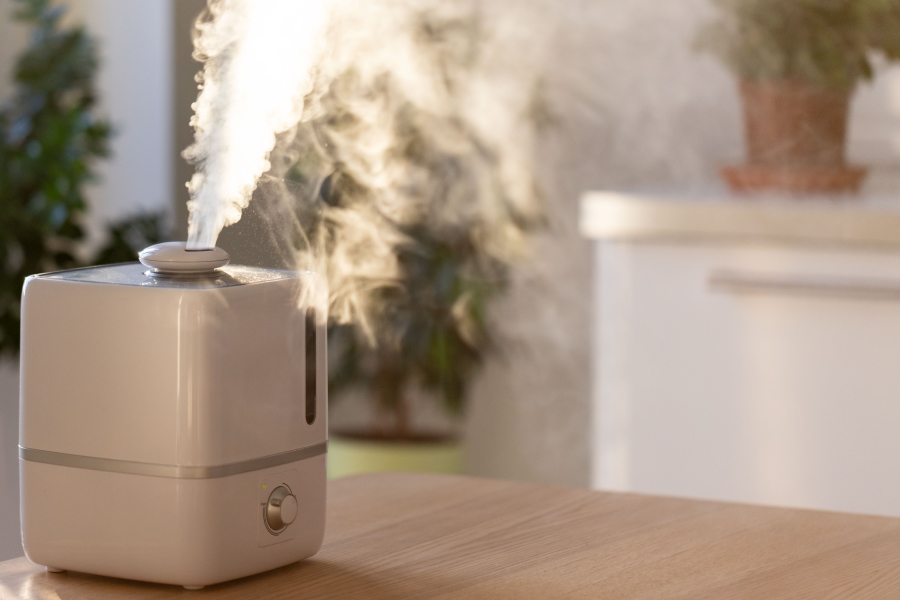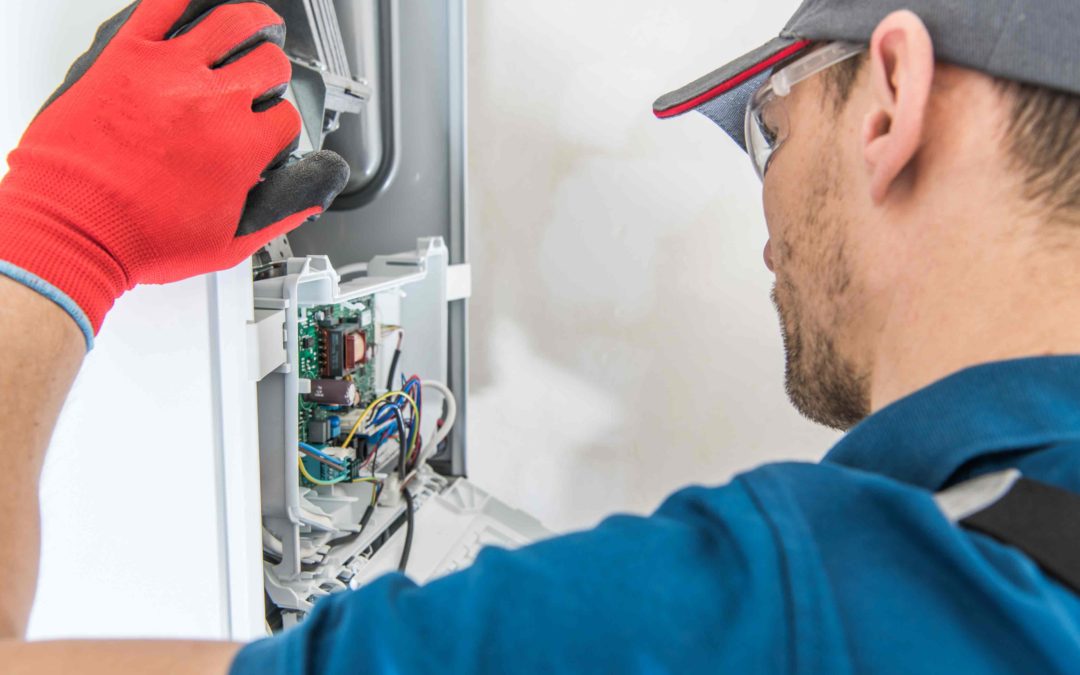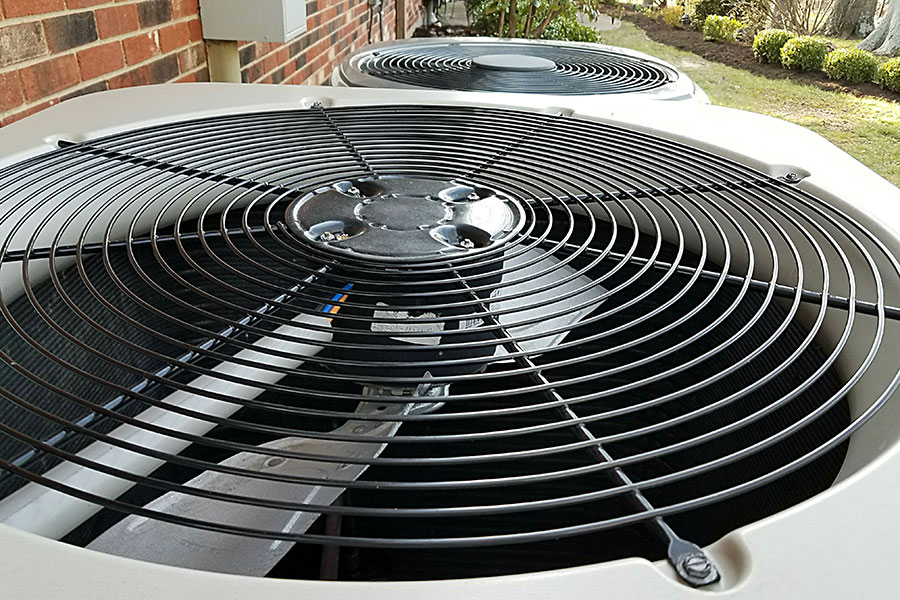
Air Purifiers
Humidifiers are a great home addition no matter the season. Dry air can impact a home at any point of the year, whether it’s the cold of winter or the heat of summer when your A/C is frequently running. According to the Mayo Clinic, dry air can cause a number of uncomfortable health conditions such as cracked lips, itchy eyes, and dry nasal passages. Humidifiers can help ease these symptoms by releasing water vapor or steam into the air to increase your home’s air moisture levels (humidity). There are many types of humidifiers on the market, so you’ll want to weigh your options and consider your home’s needs before selecting one. Let’s explore the types of humidifiers out there so you can select the best one for your home in 2022 and beyond.
Types of Humidifiers
Central Humidifier
Also known as a whole home humidifier, central humidifiers are built into your home’s HVAC system to evenly humidify your entire home. There are three different types of humidifiers for whole-home use: bypass humidifiers, fan-powered humidifiers, and steam humidifiers.
- Bypass Humidifiers – A bypass humidifier adds moisture to warm air through a furnace. They channel warm air from a home’s HVAC system and pass it through a water tray. This lets the air collect moisture which is then expelled back into the house.
- Fan-Powered Humidifiers – These models are very similar to bypass humidifiers except they use a fan to push air through a water tray. Fan-powered humidifiers typically produce more humidity than bypass humidifiers and are very energy efficient.
- Steam Humidifiers – Steam humidifiers are powerful units often used to heat large homes. Whole house steam humidifiers use electricity to boil water, which creates steam. The steam is pushed through the house’s vents to increase humidity.
Evaporator Humidifier
Evaporator humidifiers blow moisture into the air through a damp filter, wick, or belt. They are fan-powered, single-unit systems, so they can only work in one room at a time. These are typically a more affordable humidifier option, but they can expel too much moisture into the air if overused. Too much humidity in the air can lead to mold growth and trigger asthma symptoms.
Impeller Humidifier
Impeller humidifiers use rotating disks running at high speeds to shoot cool mist into the air. Like evaporators, these units can only work in one room at a time. The upside is impeller humidifiers are very child-friendly devices because they have no burn risk. However, overusing one of these units can trigger allergy reactions.
Steam Humidifier
These are extremely portable and inexpensive humidifier units powered by electricity. Steam humidifiers work by heating water then cooling it back down before expelling it into the air. They can cause burns, so small children need to be watched while around these humidifiers.
Ultrasonic Humidifier
Ultrasonic humidifiers use ultrasonic vibration to produce a cool mist. They come in both cool and warm mist versions and are available in a variety of sizes.
How to Choose the Best Humidifier for You
1. Consider Your Space
How much space do you need to humidify? If your entire home has dry air, selecting a whole home humidifier may be your best choice. If you want to increase humidity in a specific room in your home, a more portable unit like a steam humidifier or impeller humidifier may be a better option. If you are looking to install a humidifier in a single room, evaluate how much space you have available to install a humidifier.
2. Evaluate Your Humidity Needs
Whether you live in a drier climate or are experiencing symptoms associated with low humidity, it’s important to consider your personal humidity needs. The Mayo Clinic indicates your home’s humidity levels should ideally be between 30% and 50%. You can purchase a hygrometer, which measures the amount of moisture in the air, from a hardware store to check your home’s current humidity levels.
3. Think about Your Desired Level of Maintenance
Different humidifier types have varying maintenance needs, so it’s important to consider how much work you want to put into maintaining your humidifier. Depending on the model, humidifiers generally need regular cleaning, filter changes, and fresh water in order to keep the air pure and free from mold and bacteria. For expert help, professional HVAC technicians can help maintain your home’s humidifier with regular cleanings, checkups, and system tests.
4. Consult with a Professional
Talking with a seasoned HVAC professional is a great way to know what type of humidifier is best for your home. Like the team at Mountain Heating and Cooling, an HVAC technician can chat with you about your personal humidity needs, evaluate your home’s HVAC system, and make an informed recommendation about which type of humidifier may best fit your goals.
Our Recommended Humidifier Brands
At Mountain Heating and Cooling, we’ve installed, worked with, and inspected many types of humidifiers, so we know which models stand up to our rigorous quality tests. We offer two types of humidifiers for whole house humidification: Honeywell Bypass Humidifier and Trane Steam Humidifier.
Honeywell Bypass Humidifier
Honeywell Home Bypass Humidifiers provide humidity throughout the entire home by hooking up to your current central heating and cooling system. Their sleek, versatile designs and easy-access pads help in managing your indoor humidity and creating an enjoyable home environment. Honeywell provides a variety of models to choose from depending on your home’s needs, and the company takes pride in their humidifiers’ efficiency and easy control systems.
Trane Steam Humidifier
Tane products are renowned for their durability and longevity, and these qualities apply to their humidifiers, as well. Trane’s steam humidifiers help increase your home’s humidity while protecting wood floors, furnishings, and moldings from the damage of dry conditions. Their quiet, automatic steam humidifier operates independently of your home’s HVAC system, so it fits a wide range of home homes.
Consult with an HVAC Technician
If you’re considering installing a humidifier in your home, chat with one of our HVAC technicians today. For over four decades, Mountain Heating and Cooling has been providing Bozeman homeowners and businesses with efficient comfort solutions, top-notch craftsmanship, and stellar customer service. We take the time to know your personal and home needs to match you with the best products that will serve your home for years to come. Your comfort and peace of mind motivate us to provide only the best-of-the-best recommendations and HVAC services! To schedule an appointment, drop us a line or give us a call at (406) 586-8630.

Heating and Cooling Solutions
One of the best ways to save money this winter is upgrading your home with an ENERGY STAR certified smart thermostat. The intuitive functions of smart thermostats open up a variety of options for you to customize your home’s settings and save money. If you have ever asked “Do smart thermostats save money in the winter?”, we’ve laid out the top benefits of smart thermostats to answer your question.
Why is ENERGY STAR Certification Important When Choosing a Smart Thermostat?
ENERGY STAR products have been verified by the United States Environmental Protection Agency to use less energy than standard products on the market. Using products that save energy creates a positive domino effect for your home and heating bills. Saving energy means saving extra work for your home, which means saving money on your heating bills. So, when you choose to use an ENERGY STAR certified smart thermostat, you are choosing a device that’s been verified to save energy, therefore saving you money.
At Mountain Heating and Cooling, we use ENERGY STAR certified products like Nexia and Trane smart thermostats to ensure your heating and cooling systems operate efficiently and cost-effectively. We use a variety of ENERGY STAR certified products, so you can consult with one of our experts to decide which of our recommended brands works best for your home.
How Do Smart Thermostats Save Money in Wintertime?
When the temperature outside drops, you typically react by cranking up the temperature inside of your home. However, this can easily lead to hefty heating bills and a lighter wallet. Smart thermostats allow you more opportunities to better regulate your heating and cooling system and optimize your home to save energy. If you’re wondering how do smart thermostats save money in the wintertime, we’ve listed the top energy-saving features of smart thermostats.
Programmable Temperature Settings
One of the main benefits of smart thermostats is being able to program custom heating and cooling settings. Smart thermostats allow you to schedule what time of day the heating kicks on or turns down, so you don’t waste extra heating power while you are away from home. During the winter, if your home has a lower interior temperature, this means you have a slower loss of heat. The slower your loss of heat, the more energy you save in the long run.
The U.S. Environmental Protection Agency recommends setting your smart thermostat to 68°F while you are at home and setting it at a lower temp while you’re asleep or away from the house. You can even save as much as 10% a year on your heating bill by turning down your thermostat by 10°F for 8 hours a day.
Uses Real-Time Weather Information
Many of the most popular smart thermostats on the market use real-time weather data to gauge what to set your home temperature at. Smart thermostats that connect to the internet can access information about the weather conditions outside of your home. Using this information, your smart thermostat can adjust the temperature of your home accordingly to save money and increase efficiency.
Accessible Setting Scheduling
One of the most convenient features of smart thermostats is their scheduling accessibility. Many smart thermostats allow you to program and adjust your home’s smart thermostat from your tablet, computer, or smartphone. You can easily lower your home’s heating temperature when you’re at the office or on vacation, helping you save energy and money.
Chat with Smart Thermostat Installation Experts
If you’re interested in installing a smart thermostat in your home this winter, reach out to the HVAC experts at Mountain Heating & Cooling. We have years of experience in finding the perfect solution for your heating and cooling needs. We know smart thermostats inside and out, and we will take the time to get to know your needs to make sure we fit the right system and model to your home. Give us a call to arrange an appointment today.

Heating and Cooling Solutions
Winter is not an easy time for your energy bill. In the colder months, you typically use more energy to heat the entire home. The constant use of heat can not only raise your bills, but it can overwork your HVAC system and lead to leaks and breaks. The last thing you want to deal with during the winter is a broken furnace. No one wants a chilly house. To keep your heating and cooling systems running efficiently and your energy bills manageable, it’s important to know how to make your home energy-friendly. A great measure of your home’s energy efficiency is the Energy Star rating system.
What is the Energy Star rating system?
Energy Star—trademarked as ENERGY STAR— is a federal voluntary program operated by the U.S. Environmental Protection Agency (EPA). Energy Star educates people on how to save money and improve the environment through energy efficiency, much of which starts in the home. To help home and building owners select energy-efficient products Energy Star researches, identifies, and promotes products that fit their standards and place their “seal of approval” on these products. They even have an Energy star rating system to show which products are the most energy-efficient and, therefore, “Energy Star Certified.”
Using tips and tricks from the Energy Star, we’ve put together a guide for keeping your electrical bills low and energy rating high during the wintertime.
Winter Energy Efficiency Guide
Regularly Change Your Air Filter
Dirty air filters slow down airflow and make your HVAC system work harder to keep your home warm. This not only wastes energy, but it overworks your system and increases your heating bill. During heavy use months, like the winter and summer, check your air filter every month. Folks often ask us how often they should change their air filter, and the answer depends on how dirty or clean it is. If it looks dirty, replace the air filter immediately. Leaving an air filter unchanged can lead to expensive maintenance or early system failure later on. If it is clean, air filters can last up to three months unchanged.
Tune or Replace HVAC Equipment
Just like regularly visiting the dentist for a cleaning, checking and tuning your HVAC equipment every year can improve its efficiency and your comfort. Ideally, have your system checked before the winter season hits so you can catch and repair any small problems before the cold weather settles in.
Since 50% of your utility bill goes into heating your home, having your furnace inspected regularly can help you save money in the long run. We recommend checking and fixing your furnace about once a year for optimal performance. With the tune-ups, remember to change your furnace filter every month or as prescribed by the manufacturer. This will help regulate the proper flow of warm air throughout your home.
If your furnace is outdated (10 or more years old) or broken beyond reasonable repair, contact an HVAC professional for furnace installation services. Many HVAC companies, like Mountain Heating and Cooling, have furnace options that are Energy Star verified, so you can have peace of mind knowing you’ve made the right choice for your space.
Clean and Check Vents
Your heating system runs best when there is nothing obstructing the flow of air from returns and vents. Having clogged or blocked vents can cause your heating system to overwork, putting out more energy than is actually needed. To ensure your vents’ efficiency, regularly clean vents by removing dust and debris. Also, move any furniture or items that are blocking your vents.
Find and Fix Leaks
Drafty windows and doors can cause nearly one-third of your home’s heat to escape. Before the cold winter air sets in, it’s important to find and fix any leaks that are draining your heating system and bank account. Things to look for leaks include cracks around ducts, window frames, doors, vents, and chimneys. You can often seal these with weatherstripping and caulking. For an expert’s advice, reach out to an HVAC professional like Mountain Heating & Cooling for an in-depth home inspection.
Now is better than later to start preparing your home for the winter. When the cold air and snowy weather hits, it can often be an inconvenience to make major changes that impact your HVAC system. To ensure your peace of mind and keep your energy bill low this winter, schedule an HVAC system check with Mountain Heating & Cooling. Our team has years of experience finding the perfect solutions for your home. We take the time to know your needs to make sure we pair the right system and model to your home. Give us a call to schedule your appointment today.

Service
The last thing you want during wintertime is to come home to a cold house. Having an operational furnace keeps you and your family cozy during the chilly season, so proper furnace maintenance is key for comfort. The fall is the perfect time to start checking on your heating & cooling system. Starting a few months ahead of time gives you enough time to inspect your furnace and call professionals to make the proper repairs. So you are ready for the snow and ice, here are seven tips to help you prepare your furnace for winter.
1. Have A Professional Checkup Before You Turn On
Your best option is to have a professional do a full inspection of your furnace before the winter hits. In fact, hiring a professional can help you save money in the long run. A professional trained in furnace maintenance can ensure furnaces are cleaned and repaired efficiently. Also, they often spot issues untrained eyes miss. HVAC professionals will be able to quickly fix any furnace issues before they grow and, potentially, ruin your entire heating system.
For professional help in your furnace maintenance needs, reach out to Mountain Heating & Cooling today.
2. Inspect Your Air Filters
Depending on your system air filter, filters need to be replaced every 1 to 3 months. Change 1” filters monthly, and 4” filters every 3 months. If you have more allergens, dander, or pet hair in your home, you may need to replace the filter more often. These factors can obstruct your heating system and prevent air from circulating throughout your home.
3. Turn On Your Thermostat
If your thermostat is not working, then your furnace may not be working. Turning on your thermostat to see if it is functioning is a good, initial step to check your heating system’s health.
If the system is working, the thermostat should turn on without any problems. If the heat doesn’t engage, you may need to either replace the thermostat or check batteries on the thermostat or breaker or fuse for power issues. If it continues to not work, you should call in a professional to address the issue.
4. Replace Old or Outdated Furnaces
Sometimes, old furnaces cost more to repair than they do to replace. Furnaces that are over 20 years old can be prone to issues that require continual maintenance to keep them running. To get the opinion of a professional about whether your furnace should be replaced or not, contact Mountain Heating & Cooling today.
5. Check Vents
Vent blockages can wreak havoc on your heating system. Blocked air vents can cause your furnace to work harder. This increases the system’s temperature and increases the risk of a fire. Before winter, clear away items that obstruct vent airflow, including furniture, toys, equipment, and plants.
6. Clean Your Ducts
Proper air duct performance and condition is often overlooked when considering the upkeep of your heating & cooling system. Clean air ducts deliver fresh air into your home, so cleaning your air ducts every few years is part of an important maintenance plan. Check your air ducts for cracks and leaks at least every two years, and repair accordingly. Additionally, examine your air ducts for cleanliness and clean every few years to improve your indoor air quality.
7. Examine Your Heat Pump
Some homes use a heat pump instead of a furnace for heating. While furnaces burn oil or gas to heat homes, heat pumps use an electrically powered condenser (similar to an air conditioner) to transfer heat from outdoors to the inside of the home utilizing your ducted system.
If you heat your home using a heat pump, proper maintenance is key. The U.S. The Department of Energy indicates a well-maintained heat pump can reduce your home’s energy consumption by 10 to 25 percent. Heat pump maintenance includes removing plants and clutter from around outside parts, inspecting and tightening electrical connections, and lubricating moving parts like motors.
Fall is the time to get a jump start on your home’s furnace maintenance so you can stay warm and safe in the winter. Having professionals take care of your furnace is the most efficient way to ensure every aspect of your HVAC system is running as it should. When your family’s comfort and home’s quality are both on the line, you can trust Mountain Heating & Cooling to ensure everything is operating as it should. We know heating & cooling maintenance from start to finish, and we take the time to know what your home needs to run smoothly. Give us a call to arrange an appointment today.

Heating and Cooling Solutions, Service
During the hot months, you want to make sure your air conditioner is blowing ice cold, clean air. For that to happen, your unit will need to be running smoothly and efficiently. Air conditioner repairs can be costly, and no one wants to deal with the air conditioner leaking or failing on a hot summer’s day. To avoid that, it pays to learn about common air conditioning problems so that you can take preventive measures to avoid huge repair bills. At Mountain Heating & Cooling, we’ve put together a list of four of the common things to watch out for this summer so you can keep your home cool.
Air Conditioner Leaking
One of the common questions we get from folks is “why is my air conditioner leaking?”. Air conditioners can leak for a variety of reasons, the most common being a clogged condensate drain line. Over time, this line can become clogged with debris like dirt or dust, which can lead to the unit leaking inside your home. Essentially, when the condensate drain line gets clogged, water can’t escape and drain to the outside of the home, so instead, it gets backed up and leaks water inside your home. Air conditioner leaks can also stem from dirty air filters or low refrigerant. As the refrigerant level gets lower, the pressure inside of your AC system lowers, too. This can also lead to your evaporator coil freezing, creating a wet mess.
Air Conditioner Freezing Up
There are a few reasons why an air conditioner might freeze. This can range from insufficient airflow to low coolant levels to blower motor problems. If your unit is freezing, we recommend getting a qualified technician to take a look so that they can diagnose the issue and get it back up and running quickly.
Air Conditioner Not Blowing Cool Air
Over time, dust, dirt, and residue can build up on the air filter and block the airflow of your unit. This can affect the condenser unit and limit how much cool air it can blow. Changing the air filter regularly will help make sure your unit is blowing ice-cold air throughout the summer.
Air Conditioner Making Noises
There are a few different sounds that air conditioners can make, and it will vary depending on what the problem is. For example, a refrigerant leak will emit a hissing sound, a fan motor issue can produce a screeching sound, and faulty electrical components can produce a buzzing sound. If you notice any unexpected sounds coming from your unit, call in a qualified technician who can take a look and pinpoint the issue quickly. We can help! Give us a call and we can take a look.
How often should I service my air conditioner?
To avoid air conditioner leaking and to gain maximum air conditioner efficiency, you should make sure your air conditioning unit is serviced regularly and by qualified experts. There is some wiggle room around how long you can leave it between air conditioner repairs, though we recommend getting your air conditioning unit serviced once per year. Dirt and neglect can cause system inefficiency and failure, and to make sure that the unit is functioning efficiently and safely, it pays to perform routine maintenance. Proper maintenance by a qualified technician will prolong the unit’s life, keep it running efficiently, prevent air conditioner leaking and issues, and make sure that your home’s air is clean, and prevent future problems.
The last thing anyone wants to deal with on a hot summer’s day is an air conditioner leaking or having issues. At Mountain Heating & Cooling we’re here to help. Let’s schedule a maintenance check now to prevent any issues and to make sure your unit is working efficiently for the rest of the summer. Give us a call to arrange an appointment today.





